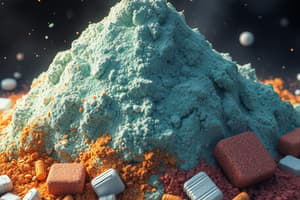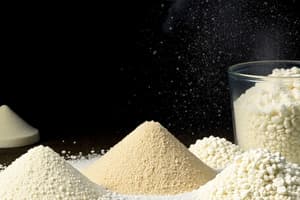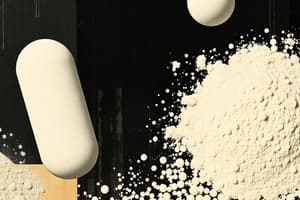Podcast
Questions and Answers
What is a primary disadvantage of sifting when blending powders?
What is a primary disadvantage of sifting when blending powders?
- It is time-consuming.
- It creates a homogeneous blend.
- It requires expensive equipment.
- It is not suitable for potent drugs. (correct)
Which method of powder mixing is characterized by being thorough but time-consuming?
Which method of powder mixing is characterized by being thorough but time-consuming?
- Blending with a spatula
- Sifting
- Tumbling (correct)
- Vibration mixing
What phenomenon occurs when fine particles are lifted while larger particles settle at the bottom during blending?
What phenomenon occurs when fine particles are lifted while larger particles settle at the bottom during blending?
- Fluidization
- Coalescence
- Segregation (correct)
- Homogenization
Which method helps prevent segregation during the blending of powders?
Which method helps prevent segregation during the blending of powders?
What is a recommended remedy for hygroscopic powders?
What is a recommended remedy for hygroscopic powders?
What type of powder can become sticky or pasty when mixed due to differing melting points?
What type of powder can become sticky or pasty when mixed due to differing melting points?
What is the best remedy for deliquescent powders?
What is the best remedy for deliquescent powders?
What should be done with explosive powders to ensure safety?
What should be done with explosive powders to ensure safety?
What is the purpose of trituration in the drug comminution process?
What is the purpose of trituration in the drug comminution process?
Which mortar type is preferred for grinding soft aggregates and crystals in a laboratory setting?
Which mortar type is preferred for grinding soft aggregates and crystals in a laboratory setting?
In the levigation process, what is the primary purpose of the levigating agent?
In the levigation process, what is the primary purpose of the levigating agent?
Which method would be most suitable for blending powdered substances that are particularly potent and available in small amounts?
Which method would be most suitable for blending powdered substances that are particularly potent and available in small amounts?
What characterizes the process of pulverization by intervention?
What characterizes the process of pulverization by intervention?
Which statement about spatulation is true?
Which statement about spatulation is true?
Which of the following is NOT a common equipment used in the levigation process?
Which of the following is NOT a common equipment used in the levigation process?
What is the end product when a levigating paste is combined with an ointment base?
What is the end product when a levigating paste is combined with an ointment base?
Which sieve classification indicates that not more than 40% of the particles can pass through?
Which sieve classification indicates that not more than 40% of the particles can pass through?
What results from a smaller particle size in terms of dissolution rate?
What results from a smaller particle size in terms of dissolution rate?
Which method of particle size determination uses a mechanical shaker and a series of sieves?
Which method of particle size determination uses a mechanical shaker and a series of sieves?
What is a key factor affecting the sedimentation rate of particles?
What is a key factor affecting the sedimentation rate of particles?
Which classification of powder has no limit to greater fineness?
Which classification of powder has no limit to greater fineness?
What aspect does lack of grittiness in solid particles affect most directly?
What aspect does lack of grittiness in solid particles affect most directly?
What does the light energy diffraction method measure in relation to particle size?
What does the light energy diffraction method measure in relation to particle size?
Which sieve number indicates that more than 40% of the particles do not pass through?
Which sieve number indicates that more than 40% of the particles do not pass through?
What is the primary characteristic that topical powders must have to avoid skin irritation?
What is the primary characteristic that topical powders must have to avoid skin irritation?
Which of the following is NOT a disadvantage of powders?
Which of the following is NOT a disadvantage of powders?
What does the flowability of a powder refer to?
What does the flowability of a powder refer to?
Which component is commonly used as an adherent in topical powders?
Which component is commonly used as an adherent in topical powders?
What is the maximum percentage of coarse powders that can pass through a No. 60 sieve?
What is the maximum percentage of coarse powders that can pass through a No. 60 sieve?
Which of the following factors is MOST critical for the characterization of a powder?
Which of the following factors is MOST critical for the characterization of a powder?
Which type of powder is specifically applied in a body cavity?
Which type of powder is specifically applied in a body cavity?
What is a common composition component that serves as a diluent in topical powders?
What is a common composition component that serves as a diluent in topical powders?
What is the primary purpose of douche powders?
What is the primary purpose of douche powders?
What is a key advantage of granules compared to powders?
What is a key advantage of granules compared to powders?
Which method of granulation is not suitable for moisture and heat sensitive drugs?
Which method of granulation is not suitable for moisture and heat sensitive drugs?
What type of paper is recommended for hydroscopic or deliquescent powders?
What type of paper is recommended for hydroscopic or deliquescent powders?
Which type of powder can be prepared using the weighing and dividing method?
Which type of powder can be prepared using the weighing and dividing method?
What is one disadvantage of the wet granulation method?
What is one disadvantage of the wet granulation method?
How are granules generally characterized in terms of particle size?
How are granules generally characterized in terms of particle size?
What is the main advantage of using dry granulation over wet granulation?
What is the main advantage of using dry granulation over wet granulation?
Flashcards are hidden until you start studying
Study Notes
Powders
- Intimate mixture of dry, finely divided drugs for both external and internal use.
- Serve as limited preparations but are foundational in creating other dosage forms.
- Considered the starting point of all dosage forms.
Classification of Powders
- Divided based on application: topical powders targeting the skin.
- Must have uniform, small particle size to avoid skin irritation.
- Characteristics include being impalpable, free-flowing, and able to adhere easily to the skin.
- Common compositions include diluents (talc/cornstarch), adherents (magnesium/calcium/zinc stearate), active ingredients, and aromatic materials.
- Examples include insufflated powders used with an insufflator for application in body cavities.
Advantages and Disadvantages
- Advantages:
- Flexibility in compounding and can be prepared in divided forms.
- Dry, stable, and provide rapid onset of action.
- Disadvantages:
- Limited wettability can delay efficacy; inaccurate dosing; unsuitable for dispensing.
- Some powders may be hygroscopic or deliquescent.
Chemical and Physical Characterization
- Essential powder characteristics include:
- Particle size and its impact on solubility.
- Solubility, morphology, purity, stability, uniformity, compatibility, and flowability.
Particle Size Analysis
- Various types of powder based on particle size analysis include:
- Very Coarse (No.8), Coarse (No.20), Moderately Coarse (No.40), Fine (No.60), Very Fine (No.80).
- Chemical origin classifications follow similar particle size categorizations.
Factors Determining Particle Size Classification
- Smaller particle sizes lead to higher dissolution rates.
- Uniform suspendability promotes consistent dosing.
- Adequate penetrability for target organ delivery.
- Lack of grittiness in final formulations is crucial.
Methods of Particle Size Determination
- Preferred to use multiple methods for accuracy:
- Sieving: Basic method involving mechanical shaking through sieves.
- Microscopy: Uses calibration grids to measure particle size.
- Sedimentation Rate: Based on particles’ settling velocity in a fluid.
- Light Energy Diffraction: Analyzes light blockage to determine size.
- Laser Holography: Advanced imaging technique using lasers.
- Cascade Impaction: Driven particles impacting surfaces by air stream.
Comminution of Drugs
- Reduces particle size using methods such as:
- Trituration: Grinding drugs in a mortar, conducted on a small scale.
- Mortar types: glass (solutions), wedgewood (crystalline solids), porcelain (soft aggregates).
- Levigation: Reduces particle size in ointments using a levigating agent.
- Pulveration by Intervention: Uses volatile solvents for sticky materials.
- Trituration: Grinding drugs in a mortar, conducted on a small scale.
Blending of Powders
- Different techniques for blending include:
- Spatulation: Light compression, suitable for small quantities.
- Trituration: Both comminution and mixing techniques; geometric dilution for potent drugs.
- Sifting: Mixed by passing through sifters but not suitable for potent drugs.
- Tumbling: Mixing in rotating chambers, thorough but time-consuming.
Undesirable Factors in Blending
- Segregation: Separation of blend components.
- Prevention measures include minimizing transfer steps, controlling dust, managing fluidization, and proper equipment design.
Types of Powders
- Eutectic Powders: Become sticky or pasty; remedied with adsorbing powders.
- Hygroscopic Powders: Absorb moisture; require storage in tight containers with desiccants.
- Deliquescent Powders: Liquefy upon moisture absorption; similar storage requirements as hygroscopic.
- Efflorescent Powders: Contain water of crystallization; prefer anhydrous forms.
- Explosive Powders: React violently when mixed; should not be combined.
Medicated or Pharmaceutical Powders
- Aerosol Powders: Inhaled using devices for quick delivery.
- Dusting Powders: Applied on the skin using containers.
- Douche Powders: Intended for hygienic vaginal use.
- Oral Powders, Detrifices: Mild abrasives for anti-cariogenic purposes.
- Insufflation Powders and Trituration Powders: Specific applications for powders.
- Divided Powders: Prepared in individual portions using moisture-resistant papers.
Granules
- Agglomerates of powdered materials prepared through dry or wet methods.
- Payload has a mesh size of 4-12, offering benefits over powders such as better flow, reduced surface area, and ease of wetting.
Methods of Granulation
- Wet Granulation: Involves the addition of liquid for binding; effective for improving compressibility and dissolution.
- Dry Granulation: Uses high pressure to aggregate particles, suitable for moisture-sensitive drugs, bypassing wetting and drying steps.
Studying That Suits You
Use AI to generate personalized quizzes and flashcards to suit your learning preferences.




